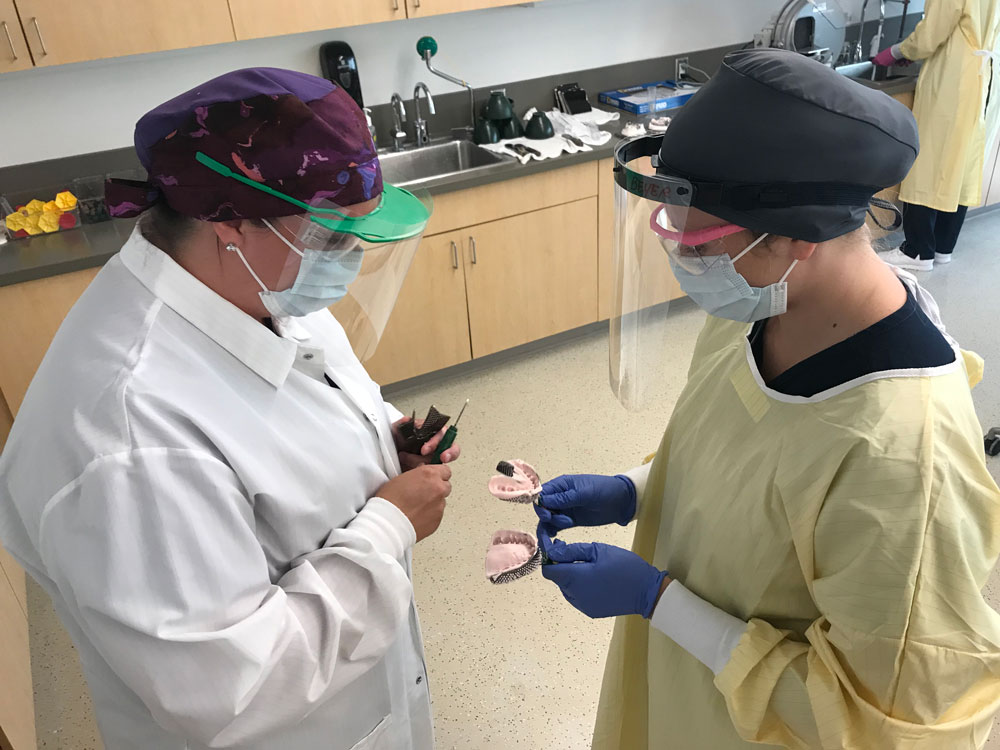Photos courtesy of GRCC
Like many students facing a new reality for courses, Alayna Helmer was stressed out when the lab and clinic portions of Grand Rapids Community College’s dental programs shut down last March to slow the spread of the novel coronavirus.
“I am not someone who really cares for online learning. I prefer to be in a classroom,” said Helmer, who is in her second and final year of GRCC’s dental hygienist program. “It isn’t really possible to do what we do online … Every patient and appointment is so different.”
Now, with clinics and labs reopened since June for in-person learning and lectures continuing online, Alayna is thankful to be back onsite learning how to care for people’s teeth. Real patients who come in for cleaning appointments provide her with the experience she needs for a future job as a hygienist in a dental office.
“I definitely feel safe being back to work and being in the clinic,” she said, explaining that dentistry always uses personal protective equipment such as masks and gloves, but has added much more during the pandemic. “I think dentistry does more than they need to, in a good way,” she said.
Still, there’s fear among patients about coming in for cleanings. “It’s been hard to recruit patients because people are afraid to come in even though GRCC has been taking every possible measure to ensure safety.”
Masks, Gowns and More
Literally one of the most in-your-face professions, dentistry requires a high level of precautions when it comes to preventing COVID-19 transmission.
“We teach students to treat everyone as if they are infectious,” said Jamie Klap, GRCC Dental Auxiliary Program director.
The GRCC staff has taken extensive measures to make sure in-person learning is possible, including air filtration systems in the clinic and lots of PPE, she said. Along with wearing N95 masks, students in the dental hygiene and dental assisting programs gear up for labs wearing long gowns, face masks, safety glasses and face shields. Klap said they are also looking into purchasing high-volume evacuation tools, which suction to exhaust aerosols as they are created.
“It will be interesting to see if there will be permanent changes in dentistry due to the pandemic,” Klap said, noting that some of the added PPE could become regular requirements.
After the campus closed to in-person learning last March, everyone worked to ensure a safe return when possible. Labs and clinics are a bit behind schedule due to the time off and the new guidelines.
“The pandemic has limited many of our abilities,” Klap said. “We stagger student arrival times to get students in and out of the locker rooms without bottlenecking the hallways. We also have a foot traffic pattern everyone follows while arriving to campus and heading to the clinic or dental lab.”
Program Numbers Limited, But Opportunities Abound
It’s a strange time to enter the profession overall. Dental offices closed during the shutdown except for emergency service and impacts of the pandemic continue, with many reporting that business has not returned to usual and they are seeing an uptick in stress-related teeth issues. Also, GRCC accepted just 16 dental hygiene students this fall, down from the typical 32, because of the need for social distancing and other safety measures.
“We have about a four-year waitlist for dental hygiene and this was a very tough and heavy weighted decision to only accept half of the students we normally do,” said Klap.
They also normally accept 24 full-time and up to six dental assisting students. This year, they accepted 20 full-time and four part-time students to the program — only a slight decrease because of the huge demand in West Michigan for registered dental assistants. Klap said she receives inquiries daily about job opportunities for students graduating from the programs.
“There is a shortage of dental assistants in West Michigan, but since COVID, I think several hygienists retired from clinical practice, leaving a gap there as well. Most of our students had full-time jobs before graduation.”
Alayna, who already works part time in a dental office, said she looks forward to the salary and flexible schedule the career offers. Starting on the low end, Klap said, hygienists earn about $25 per hour and dental assistants about $18. The average dental hygienist salary in the U.S. tops $75,000.
Most of all, though, Alayna likes to play a role in people’s health care, both by improving their teeth and by making them aware that a healthy mouth contributes to better health overall.
“I really didn’t know I’d love it so much,” she said of the program. “I like that I am able to help people with their overall health. Not many people realize that keeping your teeth clean affects your body.”














